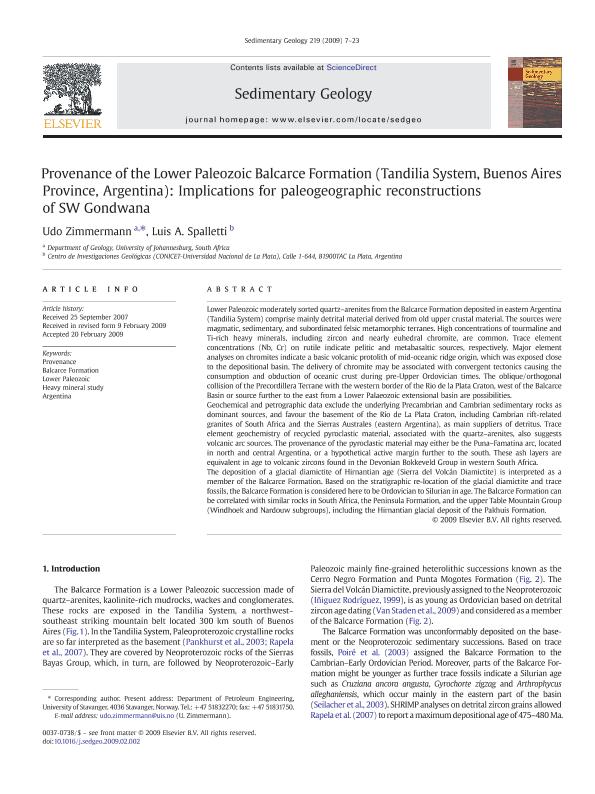Mostrar el registro sencillo del ítem
dc.contributor.author
Zimmermann, Udo

dc.contributor.author
Spalletti, Luis Antonio

dc.date.available
2019-03-26T15:55:48Z
dc.date.issued
2009-07
dc.identifier.citation
Zimmermann, Udo; Spalletti, Luis Antonio; Provenance of the Lower Paleozoic Balcarce Formation (Tandilia System, Buenos Aires Province, Argentina): Implications for paleogeographic reconstructions of SW Gondwana; Elsevier Science; Sedimentary Geology; 219; 1-4; 7-2009; 7-23
dc.identifier.issn
0037-0738
dc.identifier.uri
http://hdl.handle.net/11336/72544
dc.description.abstract
Lower Paleozoic moderately sorted quartz-arenites from the Balcarce Formation deposited in eastern Argentina (Tandilia System) comprise mainly detrital material derived from old upper crustal material. The sources were magmatic, sedimentary, and subordinated felsic metamorphic terranes. High concentrations of tourmaline and Ti-rich heavy minerals, including zircon and nearly euhedral chromite, are common. Trace element concentrations (Nb, Cr) on rutile indicate pelitic and metabasaltic sources, respectively. Major element analyses on chromites indicate a basic volcanic protolith of mid-oceanic ridge origin, which was exposed close to the depositional basin. The delivery of chromite may be associated with convergent tectonics causing the consumption and obduction of oceanic crust during pre-Upper Ordovician times. The oblique/orthogonal collision of the Precordillera Terrane with the western border of the Rio de la Plata Craton, west of the Balcarce Basin or source further to the east from a Lower Palaeozoic extensional basin are possibilities. Geochemical and petrographic data exclude the underlying Precambrian and Cambrian sedimentary rocks as dominant sources, and favour the basement of the Río de La Plata Craton, including Cambrian rift-related granites of South Africa and the Sierras Australes (eastern Argentina), as main suppliers of detritus. Trace element geochemistry of recycled pyroclastic material, associated with the quartz-arenites, also suggests volcanic arc sources. The provenance of the pyroclastic material may either be the Puna-Famatina arc, located in north and central Argentina, or a hypothetical active margin further to the south. These ash layers are equivalent in age to volcanic zircons found in the Devonian Bokkeveld Group in western South Africa. The deposition of a glacial diamictite of Hirnantian age (Sierra del Volcán Diamictite) is interpreted as a member of the Balcarce Formation. Based on the stratigraphic re-location of the glacial diamictite and trace fossils, the Balcarce Formation is considered here to be Ordovician to Silurian in age. The Balcarce Formation can be correlated with similar rocks in South Africa, the Peninsula Formation, and the upper Table Mountain Group (Windhoek and Nardouw subgroups), including the Hirnantian glacial deposit of the Pakhuis Formation. © 2009 Elsevier B.V. All rights reserved.
dc.format
application/pdf
dc.language.iso
eng
dc.publisher
Elsevier Science

dc.rights
info:eu-repo/semantics/openAccess
dc.rights.uri
https://creativecommons.org/licenses/by-nc-sa/2.5/ar/
dc.subject
Argentina
dc.subject
Balcarce Formation
dc.subject
Heavy Mineral Study
dc.subject
Lower Paleozoic
dc.subject
Provenance
dc.subject.classification
Meteorología y Ciencias Atmosféricas

dc.subject.classification
Ciencias de la Tierra y relacionadas con el Medio Ambiente

dc.subject.classification
CIENCIAS NATURALES Y EXACTAS

dc.title
Provenance of the Lower Paleozoic Balcarce Formation (Tandilia System, Buenos Aires Province, Argentina): Implications for paleogeographic reconstructions of SW Gondwana
dc.type
info:eu-repo/semantics/article
dc.type
info:ar-repo/semantics/artículo
dc.type
info:eu-repo/semantics/publishedVersion
dc.date.updated
2019-03-18T14:42:42Z
dc.journal.volume
219
dc.journal.number
1-4
dc.journal.pagination
7-23
dc.journal.pais
Países Bajos

dc.journal.ciudad
Amsterdam
dc.description.fil
Fil: Zimmermann, Udo. University of Johannesburg; Sudáfrica
dc.description.fil
Fil: Spalletti, Luis Antonio. Consejo Nacional de Investigaciones Científicas y Técnicas. Centro Científico Tecnológico Conicet - La Plata. Centro de Investigaciones Geológicas. Universidad Nacional de La Plata. Facultad de Ciencias Naturales y Museo. Centro de Investigaciones Geológicas; Argentina
dc.journal.title
Sedimentary Geology

dc.relation.alternativeid
info:eu-repo/semantics/altIdentifier/url/https://www.sciencedirect.com/science/article/pii/S0037073809000426
dc.relation.alternativeid
info:eu-repo/semantics/altIdentifier/doi/https://doi.org/10.1016/j.sedgeo.2009.02.002
Archivos asociados
